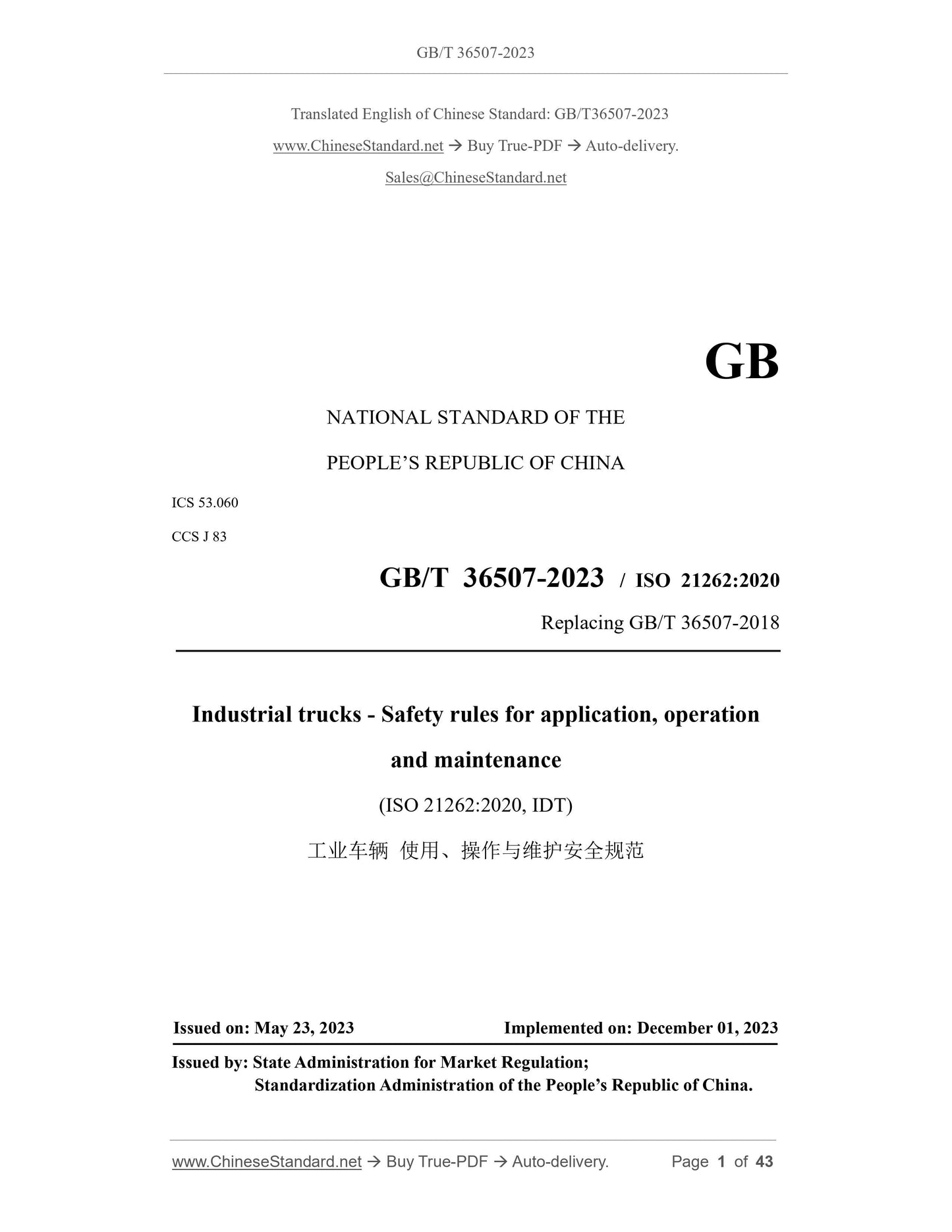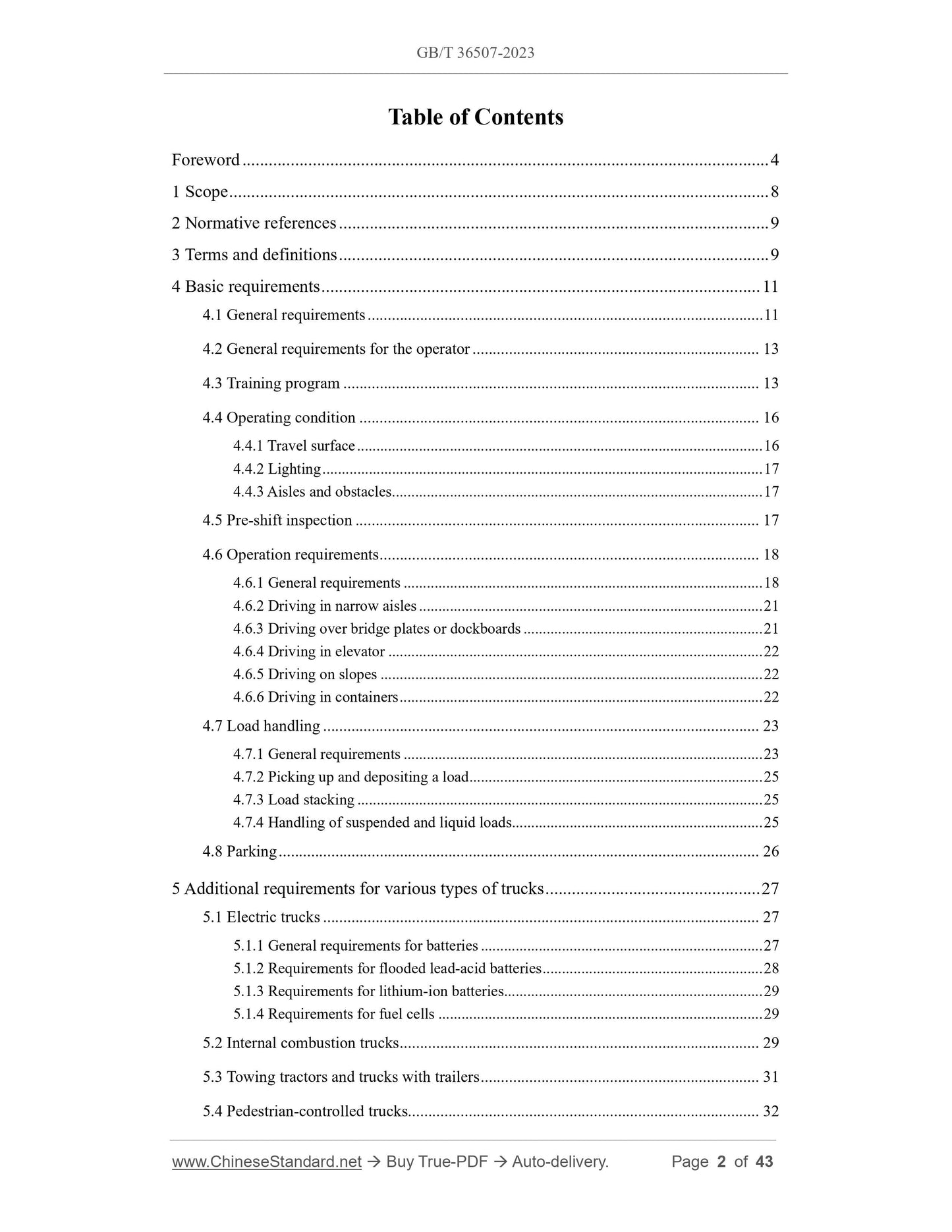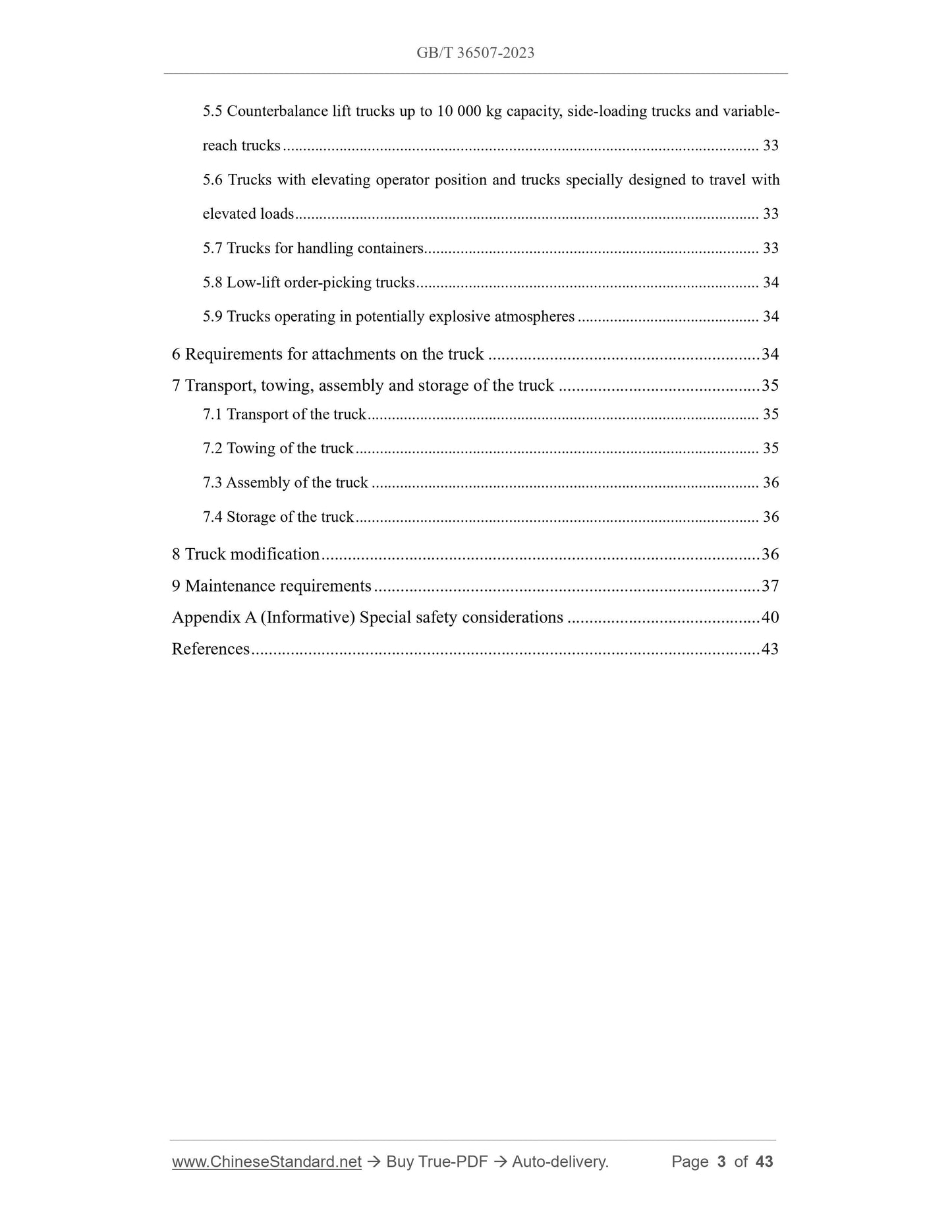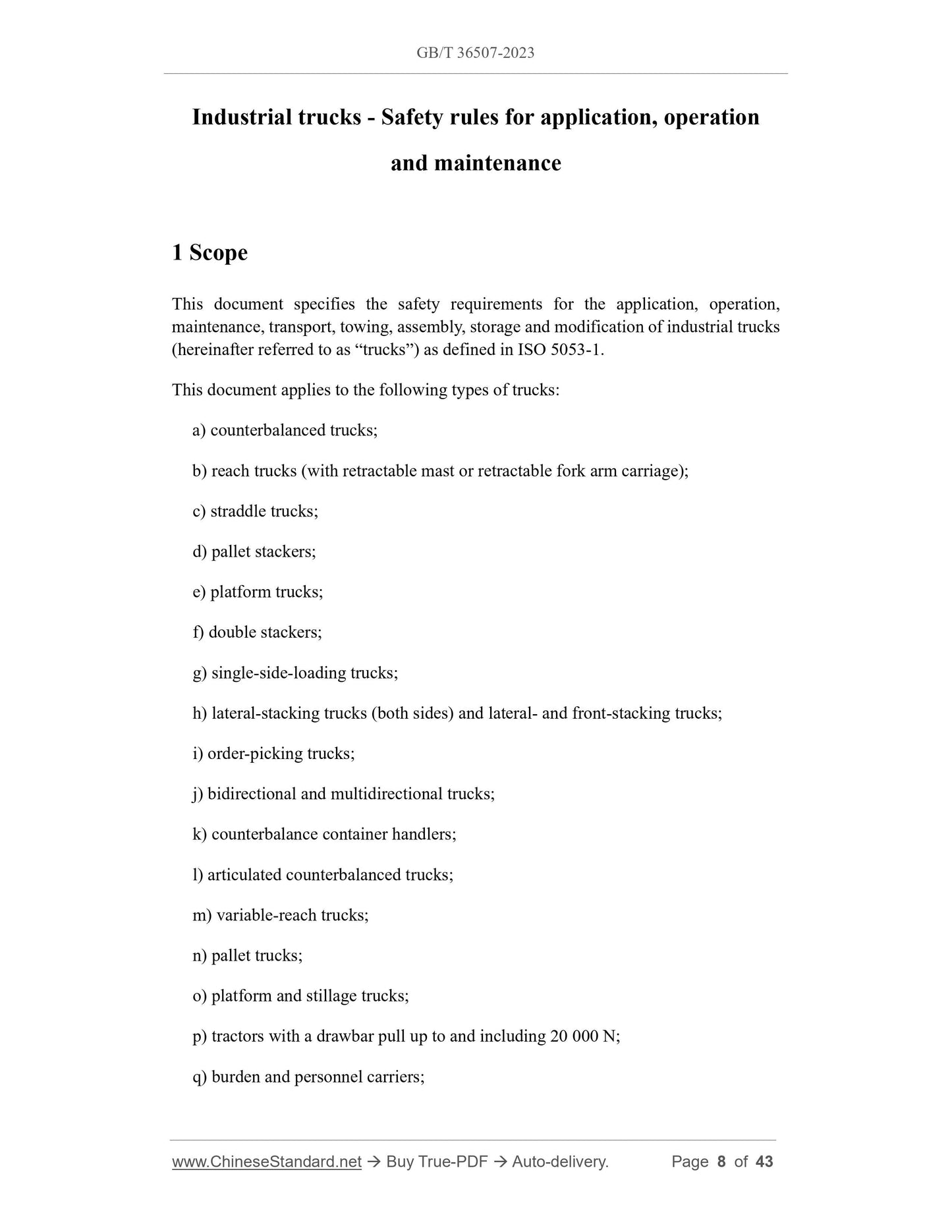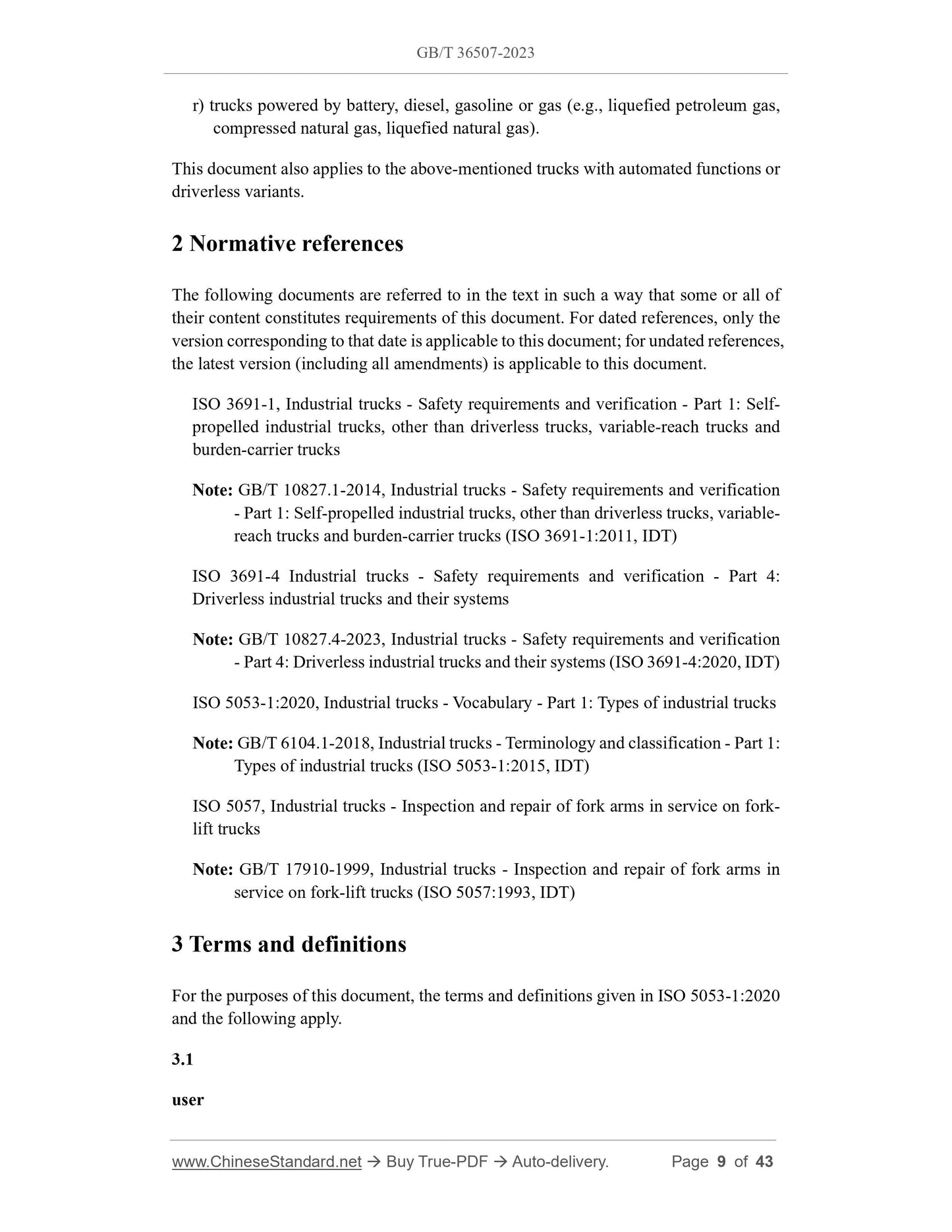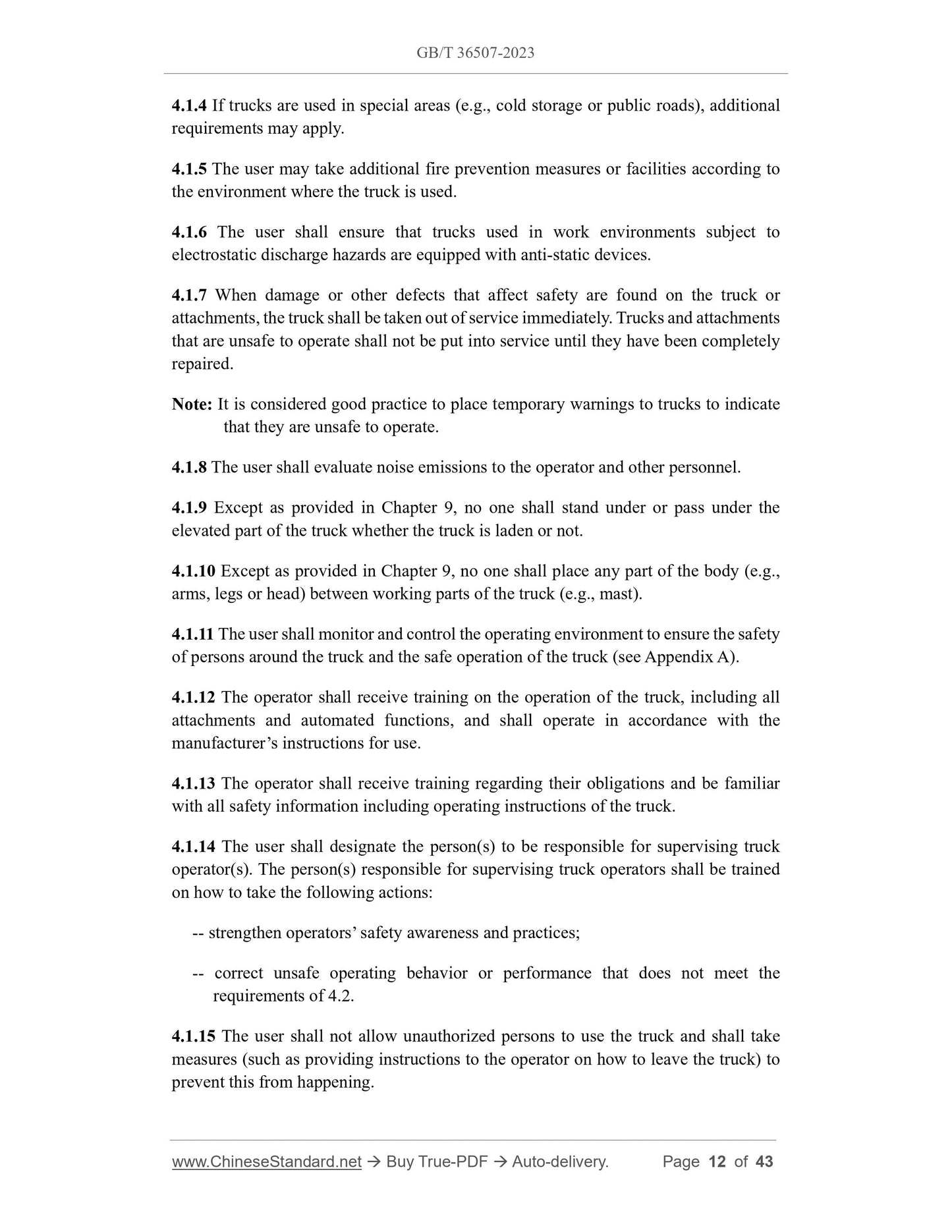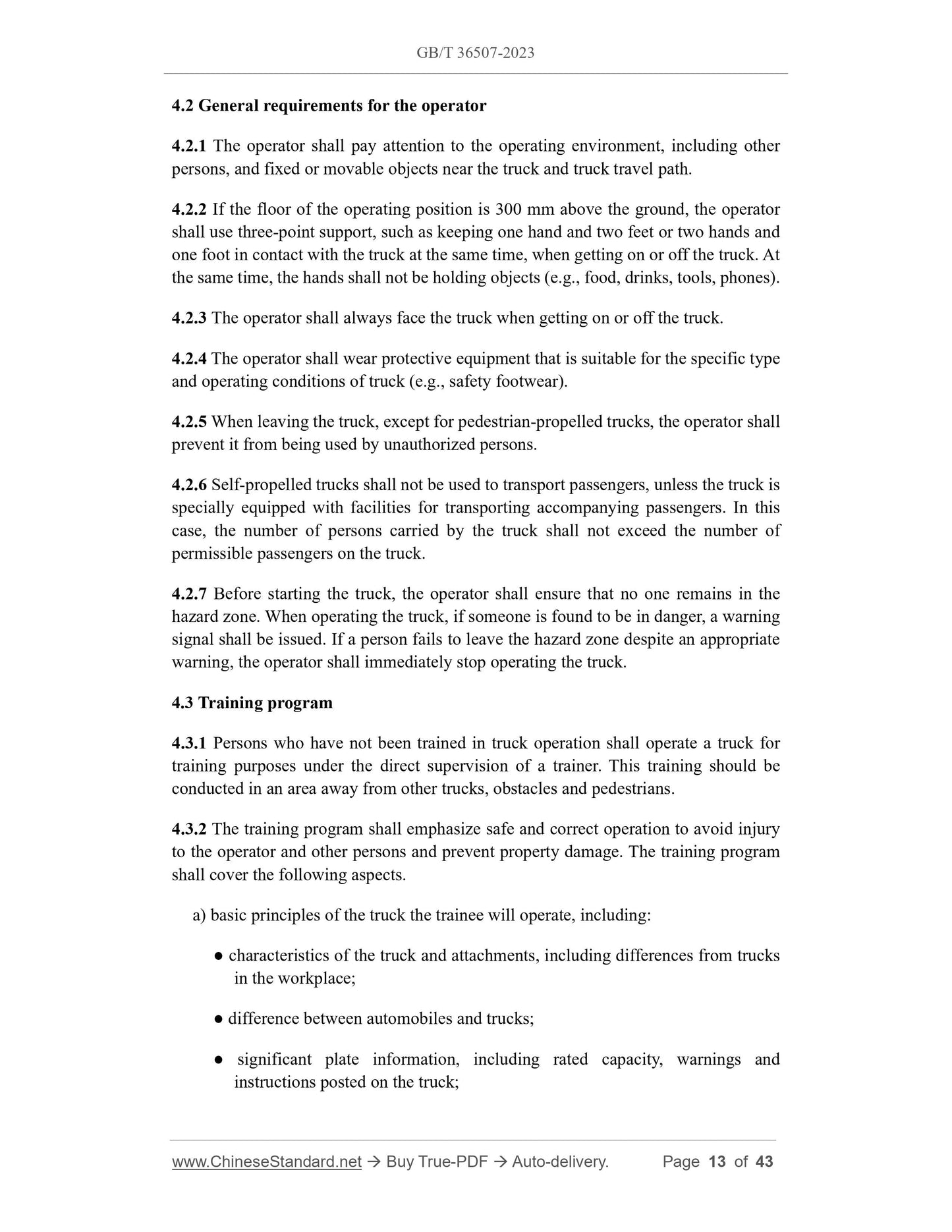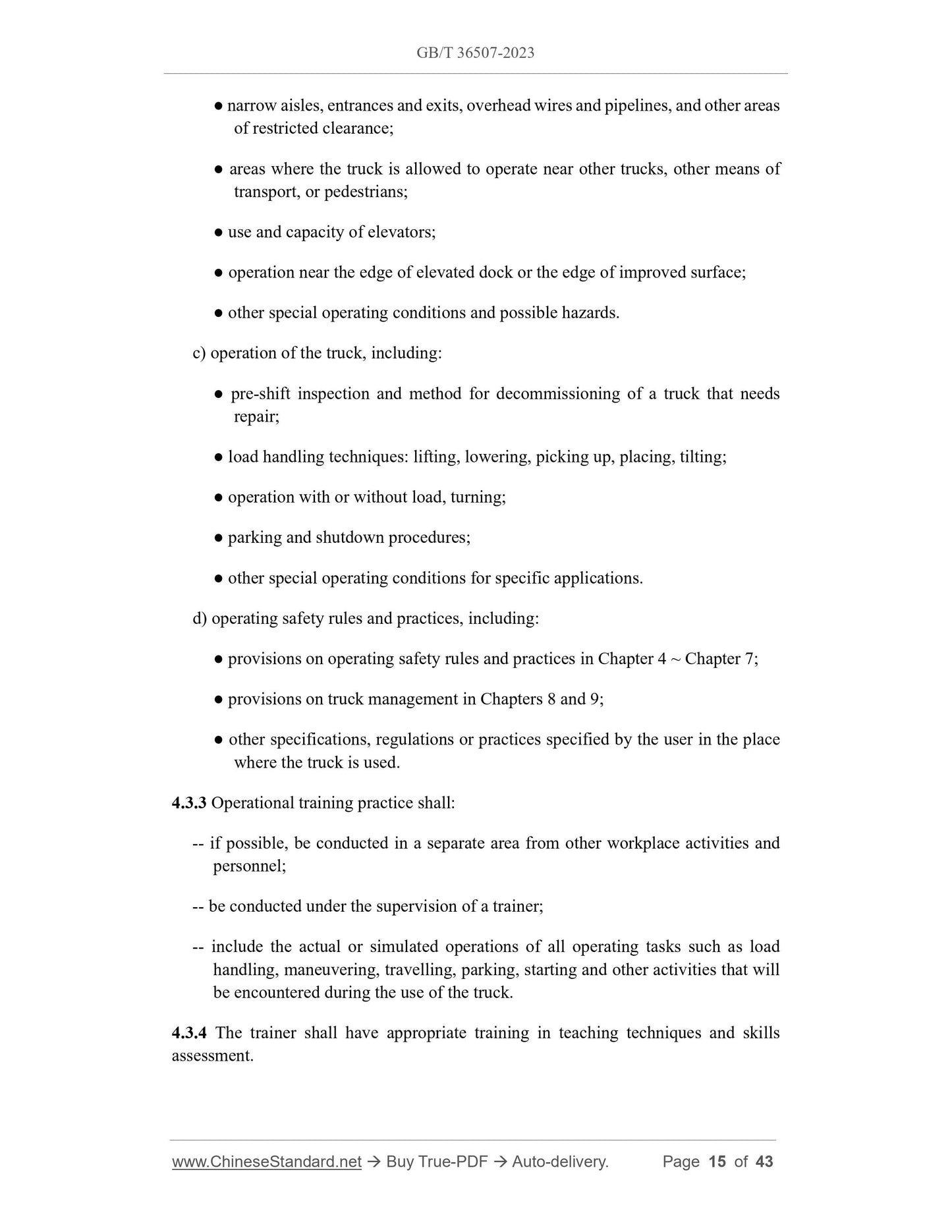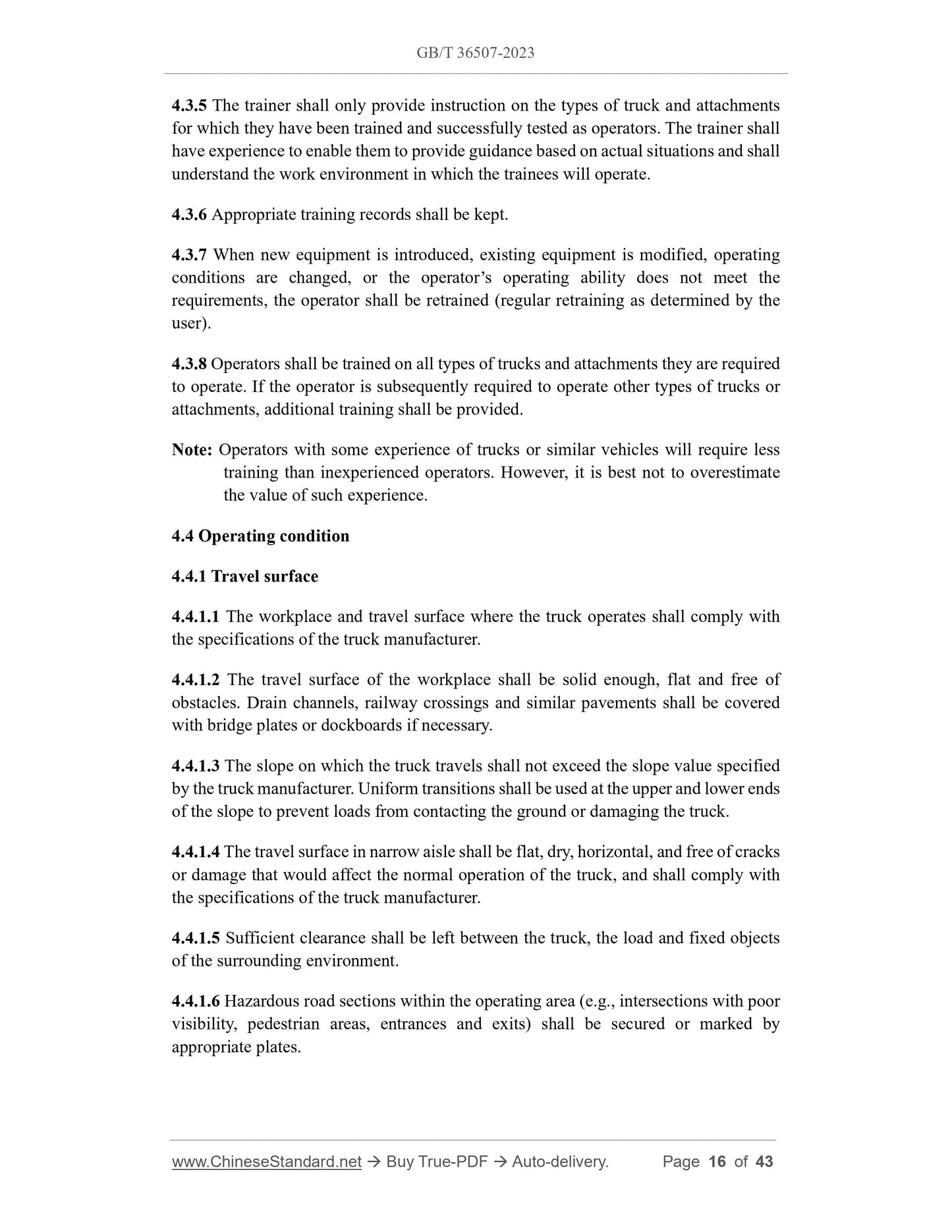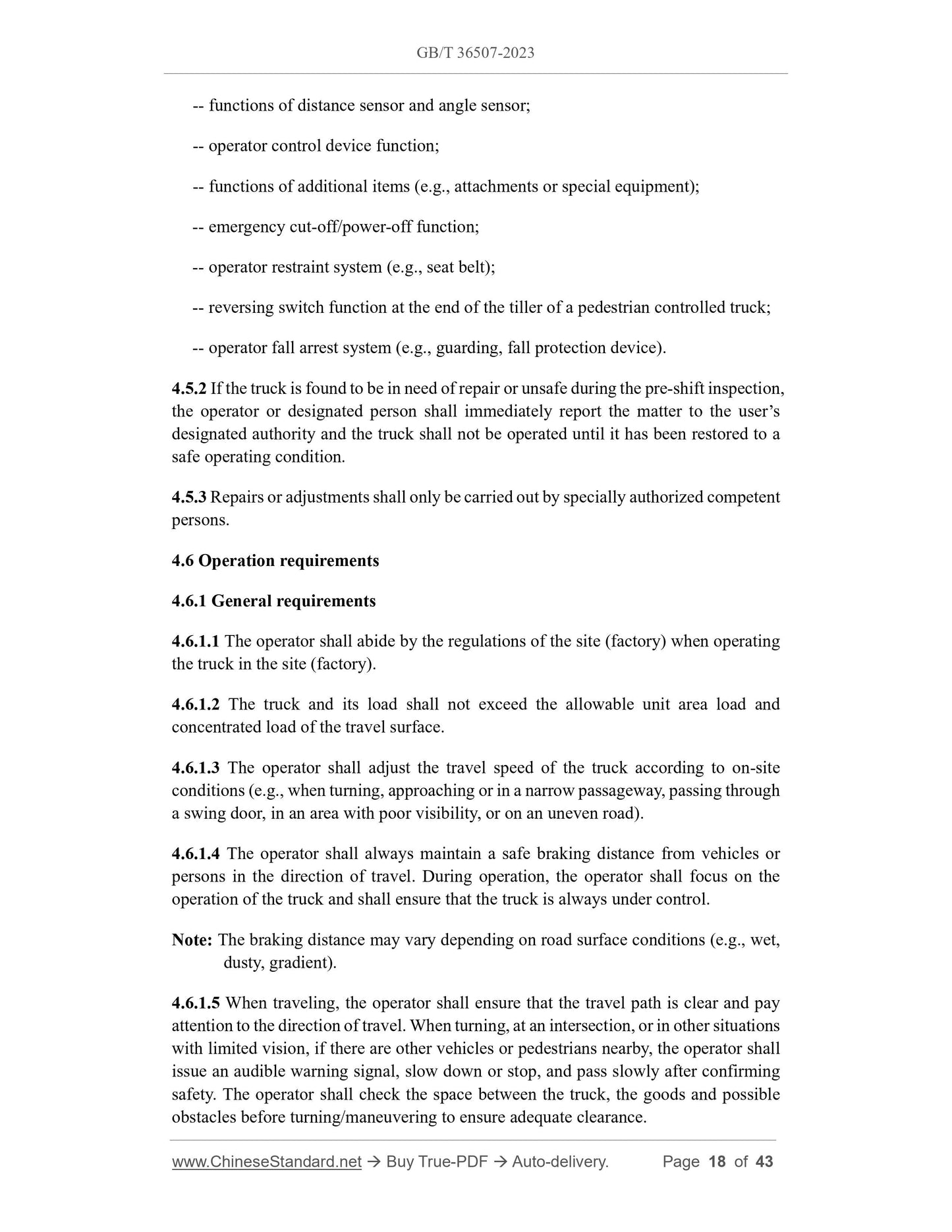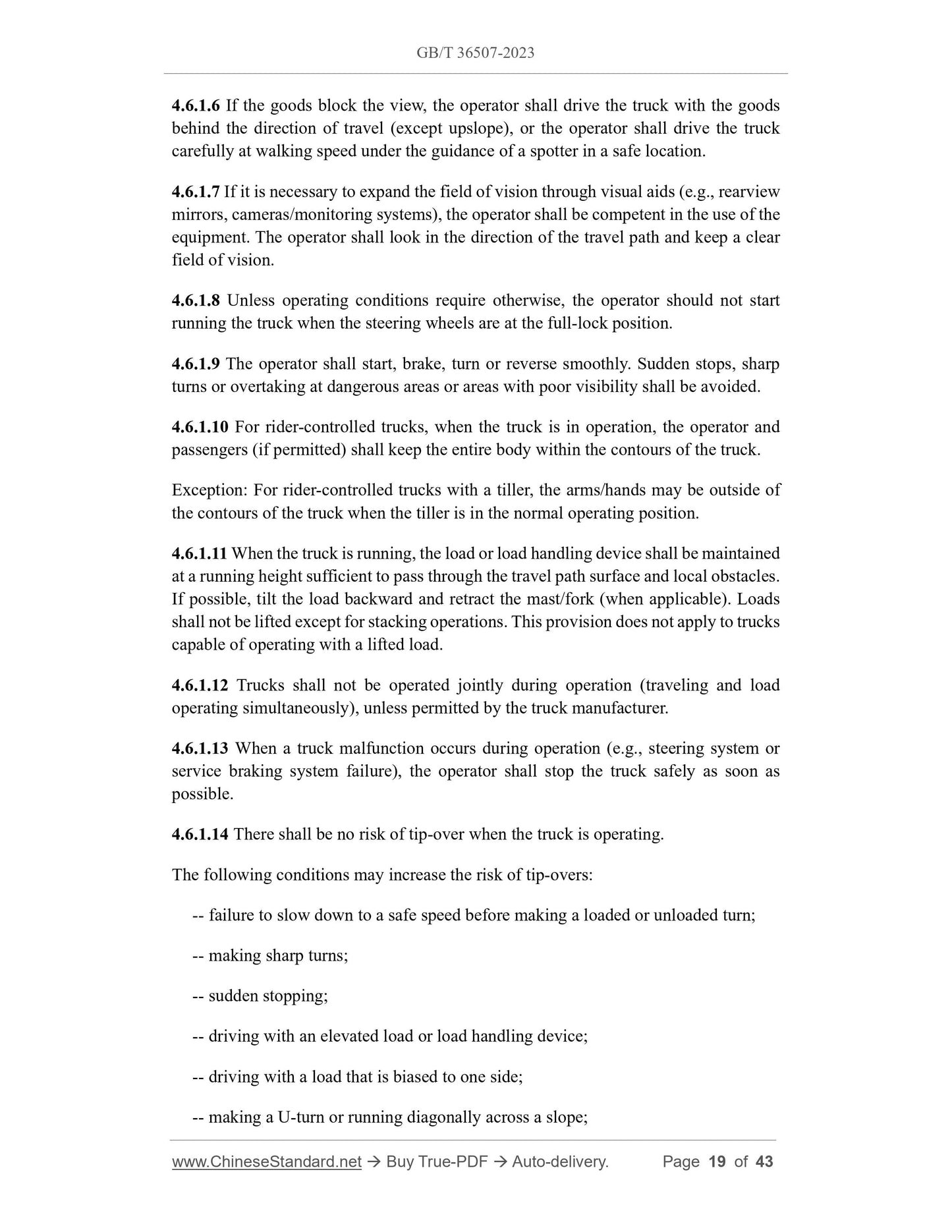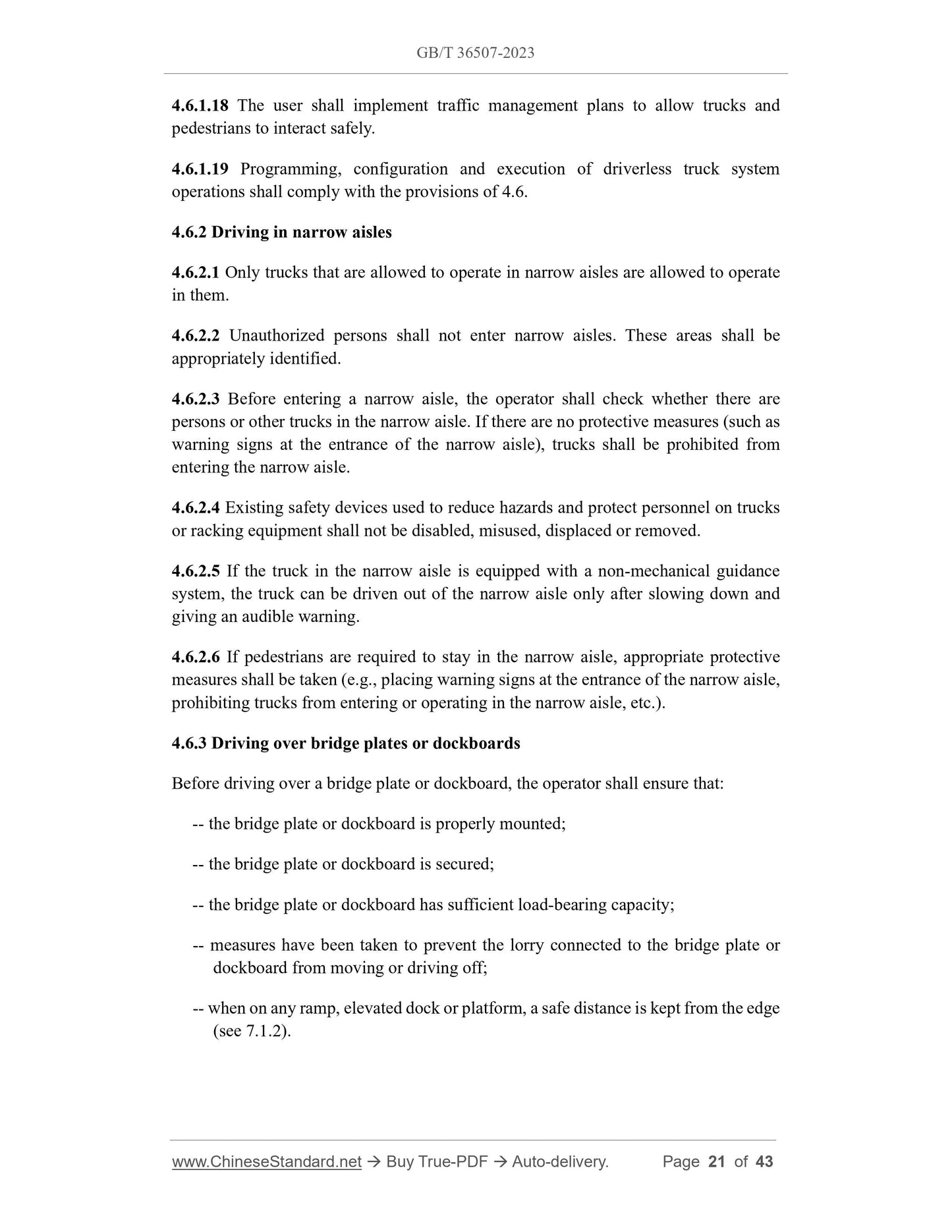1
/
de
12
PayPal, credit cards. Download editable-PDF and invoice in 1 second!
GB/T 36507-2023 English PDF (GBT36507-2023)
GB/T 36507-2023 English PDF (GBT36507-2023)
Prix habituel
$380.00 USD
Prix habituel
Prix promotionnel
$380.00 USD
Prix unitaire
/
par
Frais d'expédition calculés à l'étape de paiement.
Impossible de charger la disponibilité du service de retrait
Delivery: 3 seconds. Download true-PDF + Invoice.
Get QUOTATION in 1-minute: Click GB/T 36507-2023
Historical versions: GB/T 36507-2023
Preview True-PDF (Reload/Scroll if blank)
GB/T 36507-2023: Industrial trucks -- Safety rules for application, operation and maintenance
GB/T 36507-2023
GB
NATIONAL STANDARD OF THE
PEOPLE’S REPUBLIC OF CHINA
ICS 53.060
CCS J 83
GB/T 36507-2023 / ISO 21262:2020
Replacing GB/T 36507-2018
Industrial trucks - Safety rules for application, operation
and maintenance
(ISO 21262:2020, IDT)
ISSUED ON: MAY 23, 2023
IMPLEMENTED ON: DECEMBER 01, 2023
Issued by: State Administration for Market Regulation;
Standardization Administration of the People’s Republic of China.
Table of Contents
Foreword ... 4
1 Scope ... 8
2 Normative references ... 9
3 Terms and definitions ... 9
4 Basic requirements ... 11
4.1 General requirements ... 11
4.2 General requirements for the operator ... 13
4.3 Training program ... 13
4.4 Operating condition ... 16
4.4.1 Travel surface ... 16
4.4.2 Lighting ... 17
4.4.3 Aisles and obstacles ... 17
4.5 Pre-shift inspection ... 17
4.6 Operation requirements ... 18
4.6.1 General requirements ... 18
4.6.2 Driving in narrow aisles ... 21
4.6.3 Driving over bridge plates or dockboards ... 21
4.6.4 Driving in elevator ... 22
4.6.5 Driving on slopes ... 22
4.6.6 Driving in containers ... 22
4.7 Load handling ... 23
4.7.1 General requirements ... 23
4.7.2 Picking up and depositing a load ... 25
4.7.3 Load stacking ... 25
4.7.4 Handling of suspended and liquid loads ... 25
4.8 Parking ... 26
5 Additional requirements for various types of trucks ... 27
5.1 Electric trucks ... 27
5.1.1 General requirements for batteries ... 27
5.1.2 Requirements for flooded lead-acid batteries ... 28
5.1.3 Requirements for lithium-ion batteries... 29
5.1.4 Requirements for fuel cells ... 29
5.2 Internal combustion trucks ... 29
5.3 Towing tractors and trucks with trailers ... 31
5.4 Pedestrian-controlled trucks ... 32
5.5 Counterbalance lift trucks up to 10 000 kg capacity, side-loading trucks and variable-
reach trucks ... 33
5.6 Trucks with elevating operator position and trucks specially designed to travel with
elevated loads ... 33
5.7 Trucks for handling containers ... 33
5.8 Low-lift order-picking trucks ... 34
5.9 Trucks operating in potentially explosive atmospheres ... 34
6 Requirements for attachments on the truck ... 34
7 Transport, towing, assembly and storage of the truck ... 35
7.1 Transport of the truck ... 35
7.2 Towing of the truck ... 35
7.3 Assembly of the truck ... 36
7.4 Storage of the truck ... 36
8 Truck modification ... 36
9 Maintenance requirements ... 37
Appendix A (Informative) Special safety considerations ... 40
References ... 43
Industrial trucks - Safety rules for application, operation
and maintenance
1 Scope
This document specifies the safety requirements for the application, operation,
maintenance, transport, towing, assembly, storage and modification of industrial trucks
(hereinafter referred to as “trucks”) as defined in ISO 5053-1.
This document applies to the following types of trucks:
a) counterbalanced trucks;
b) reach trucks (with retractable mast or retractable fork arm carriage);
c) straddle trucks;
d) pallet stackers;
e) platform trucks;
f) double stackers;
g) single-side-loading trucks;
h) lateral-stacking trucks (both sides) and lateral- and front-stacking trucks;
i) order-picking trucks;
j) bidirectional and multidirectional trucks;
k) counterbalance container handlers;
l) articulated counterbalanced trucks;
m) variable-reach trucks;
n) pallet trucks;
o) platform and stillage trucks;
p) tractors with a drawbar pull up to and including 20 000 N;
q) burden and personnel carriers;
r) trucks powered by battery, diesel, gasoline or gas (e.g., liquefied petroleum gas,
compressed natural gas, liquefied natural gas).
This document also applies to the above-mentioned trucks with automated functions or
driverless variants.
2 Normative references
The following documents are referred to in the text in such a way that some or all of
their content constitutes requirements of this document. For dated references, only the
version corresponding to that date is applicable to this document; for undated references,
the latest version (including all amendments) is applicable to this document.
ISO 3691-1, Industrial trucks - Safety requirements and verification - Part 1: Self-
propelled industrial trucks, other than driverless trucks, variable-reach trucks and
burden-carrier trucks
Note: GB/T 10827.1-2014, Industrial trucks - Safety requirements and verification
- Part 1: Self-propelled industrial trucks, other than driverless trucks, variable-
reach trucks and burden-carrier trucks (ISO 3691-1:2011, IDT)
ISO 3691-4 Industrial trucks - Safety requirements and verification - Part 4:
Driverless industrial trucks and their systems
Note: GB/T 10827.4-2023, Industrial trucks - Safety requirements and verification
- Part 4: Driverless industrial trucks and their systems (ISO 3691-4:2020, IDT)
ISO 5053-1:2020, Industrial trucks - Vocabulary - Part 1: Types of industrial trucks
Note: GB/T 6104.1-2018, Industrial trucks - Terminology and classification - Part 1:
Types of industrial trucks (ISO 5053-1:2015, IDT)
ISO 5057, Industrial trucks - Inspection and repair of fork arms in service on fork-
lift trucks
Note: GB/T 17910-1999, Industrial trucks - Inspection and repair of fork arms in
service on fork-lift trucks (ISO 5057:1993, IDT)
3 Terms and definitions
For the purposes of this document, the terms and definitions given in ISO 5053-1:2020
and the following apply.
3.1
user
4.1.4 If trucks are used in special areas (e.g., cold storage or public roads), additional
requirements may apply.
4.1.5 The user may take additional fire prevention measures or facilities according to
the environment where the truck is used.
4.1.6 The user shall ensure that trucks used in work environments subject to
electrostatic discharge hazards are equipped with anti-static devices.
4.1.7 When damage or other defects that affect safety are found on the truck or
attachments, the truck shall be taken out of service immediately. Trucks and attachments
that are unsafe to operate shall not be put into service until they have been completely
repaired.
Note: It is considered good practice to place temporary warnings to trucks to indicate
that they are unsafe to operate.
4.1.8 The user shall evaluate noise emissions to the operator and other personnel.
4.1.9 Except as provided in Chapter 9, no one shall stand under or pass under the
elevated part of the truck whether the truck is laden or not.
4.1.10 Except as provided in Chapter 9, no one shall place any part of the body (e.g.,
arms, legs or head) between working parts of the truck (e.g., mast).
4.1.11 The user shall monitor and control the operating environment to ensure the safety
of persons around the truck and the safe operation of the truck (see Appendix A).
4.1.12 The operator shall receive training on the operation of the truck, including all
attachments and automated functions, and shall operate in accordance with the
manufacturer’s instructions for use.
4.1.13 The operator shall receive training regarding their obligations and be familiar
with all safety information including operating instructions of the truck.
4.1.14 The user shall designate the person(s) to be responsible for supervising truck
operator(s). The person(s) responsible for supervising truck operators shall be trained
on how to take the following actions:
-...
Get QUOTATION in 1-minute: Click GB/T 36507-2023
Historical versions: GB/T 36507-2023
Preview True-PDF (Reload/Scroll if blank)
GB/T 36507-2023: Industrial trucks -- Safety rules for application, operation and maintenance
GB/T 36507-2023
GB
NATIONAL STANDARD OF THE
PEOPLE’S REPUBLIC OF CHINA
ICS 53.060
CCS J 83
GB/T 36507-2023 / ISO 21262:2020
Replacing GB/T 36507-2018
Industrial trucks - Safety rules for application, operation
and maintenance
(ISO 21262:2020, IDT)
ISSUED ON: MAY 23, 2023
IMPLEMENTED ON: DECEMBER 01, 2023
Issued by: State Administration for Market Regulation;
Standardization Administration of the People’s Republic of China.
Table of Contents
Foreword ... 4
1 Scope ... 8
2 Normative references ... 9
3 Terms and definitions ... 9
4 Basic requirements ... 11
4.1 General requirements ... 11
4.2 General requirements for the operator ... 13
4.3 Training program ... 13
4.4 Operating condition ... 16
4.4.1 Travel surface ... 16
4.4.2 Lighting ... 17
4.4.3 Aisles and obstacles ... 17
4.5 Pre-shift inspection ... 17
4.6 Operation requirements ... 18
4.6.1 General requirements ... 18
4.6.2 Driving in narrow aisles ... 21
4.6.3 Driving over bridge plates or dockboards ... 21
4.6.4 Driving in elevator ... 22
4.6.5 Driving on slopes ... 22
4.6.6 Driving in containers ... 22
4.7 Load handling ... 23
4.7.1 General requirements ... 23
4.7.2 Picking up and depositing a load ... 25
4.7.3 Load stacking ... 25
4.7.4 Handling of suspended and liquid loads ... 25
4.8 Parking ... 26
5 Additional requirements for various types of trucks ... 27
5.1 Electric trucks ... 27
5.1.1 General requirements for batteries ... 27
5.1.2 Requirements for flooded lead-acid batteries ... 28
5.1.3 Requirements for lithium-ion batteries... 29
5.1.4 Requirements for fuel cells ... 29
5.2 Internal combustion trucks ... 29
5.3 Towing tractors and trucks with trailers ... 31
5.4 Pedestrian-controlled trucks ... 32
5.5 Counterbalance lift trucks up to 10 000 kg capacity, side-loading trucks and variable-
reach trucks ... 33
5.6 Trucks with elevating operator position and trucks specially designed to travel with
elevated loads ... 33
5.7 Trucks for handling containers ... 33
5.8 Low-lift order-picking trucks ... 34
5.9 Trucks operating in potentially explosive atmospheres ... 34
6 Requirements for attachments on the truck ... 34
7 Transport, towing, assembly and storage of the truck ... 35
7.1 Transport of the truck ... 35
7.2 Towing of the truck ... 35
7.3 Assembly of the truck ... 36
7.4 Storage of the truck ... 36
8 Truck modification ... 36
9 Maintenance requirements ... 37
Appendix A (Informative) Special safety considerations ... 40
References ... 43
Industrial trucks - Safety rules for application, operation
and maintenance
1 Scope
This document specifies the safety requirements for the application, operation,
maintenance, transport, towing, assembly, storage and modification of industrial trucks
(hereinafter referred to as “trucks”) as defined in ISO 5053-1.
This document applies to the following types of trucks:
a) counterbalanced trucks;
b) reach trucks (with retractable mast or retractable fork arm carriage);
c) straddle trucks;
d) pallet stackers;
e) platform trucks;
f) double stackers;
g) single-side-loading trucks;
h) lateral-stacking trucks (both sides) and lateral- and front-stacking trucks;
i) order-picking trucks;
j) bidirectional and multidirectional trucks;
k) counterbalance container handlers;
l) articulated counterbalanced trucks;
m) variable-reach trucks;
n) pallet trucks;
o) platform and stillage trucks;
p) tractors with a drawbar pull up to and including 20 000 N;
q) burden and personnel carriers;
r) trucks powered by battery, diesel, gasoline or gas (e.g., liquefied petroleum gas,
compressed natural gas, liquefied natural gas).
This document also applies to the above-mentioned trucks with automated functions or
driverless variants.
2 Normative references
The following documents are referred to in the text in such a way that some or all of
their content constitutes requirements of this document. For dated references, only the
version corresponding to that date is applicable to this document; for undated references,
the latest version (including all amendments) is applicable to this document.
ISO 3691-1, Industrial trucks - Safety requirements and verification - Part 1: Self-
propelled industrial trucks, other than driverless trucks, variable-reach trucks and
burden-carrier trucks
Note: GB/T 10827.1-2014, Industrial trucks - Safety requirements and verification
- Part 1: Self-propelled industrial trucks, other than driverless trucks, variable-
reach trucks and burden-carrier trucks (ISO 3691-1:2011, IDT)
ISO 3691-4 Industrial trucks - Safety requirements and verification - Part 4:
Driverless industrial trucks and their systems
Note: GB/T 10827.4-2023, Industrial trucks - Safety requirements and verification
- Part 4: Driverless industrial trucks and their systems (ISO 3691-4:2020, IDT)
ISO 5053-1:2020, Industrial trucks - Vocabulary - Part 1: Types of industrial trucks
Note: GB/T 6104.1-2018, Industrial trucks - Terminology and classification - Part 1:
Types of industrial trucks (ISO 5053-1:2015, IDT)
ISO 5057, Industrial trucks - Inspection and repair of fork arms in service on fork-
lift trucks
Note: GB/T 17910-1999, Industrial trucks - Inspection and repair of fork arms in
service on fork-lift trucks (ISO 5057:1993, IDT)
3 Terms and definitions
For the purposes of this document, the terms and definitions given in ISO 5053-1:2020
and the following apply.
3.1
user
4.1.4 If trucks are used in special areas (e.g., cold storage or public roads), additional
requirements may apply.
4.1.5 The user may take additional fire prevention measures or facilities according to
the environment where the truck is used.
4.1.6 The user shall ensure that trucks used in work environments subject to
electrostatic discharge hazards are equipped with anti-static devices.
4.1.7 When damage or other defects that affect safety are found on the truck or
attachments, the truck shall be taken out of service immediately. Trucks and attachments
that are unsafe to operate shall not be put into service until they have been completely
repaired.
Note: It is considered good practice to place temporary warnings to trucks to indicate
that they are unsafe to operate.
4.1.8 The user shall evaluate noise emissions to the operator and other personnel.
4.1.9 Except as provided in Chapter 9, no one shall stand under or pass under the
elevated part of the truck whether the truck is laden or not.
4.1.10 Except as provided in Chapter 9, no one shall place any part of the body (e.g.,
arms, legs or head) between working parts of the truck (e.g., mast).
4.1.11 The user shall monitor and control the operating environment to ensure the safety
of persons around the truck and the safe operation of the truck (see Appendix A).
4.1.12 The operator shall receive training on the operation of the truck, including all
attachments and automated functions, and shall operate in accordance with the
manufacturer’s instructions for use.
4.1.13 The operator shall receive training regarding their obligations and be familiar
with all safety information including operating instructions of the truck.
4.1.14 The user shall designate the person(s) to be responsible for supervising truck
operator(s). The person(s) responsible for supervising truck operators shall be trained
on how to take the following actions:
-...
Share
